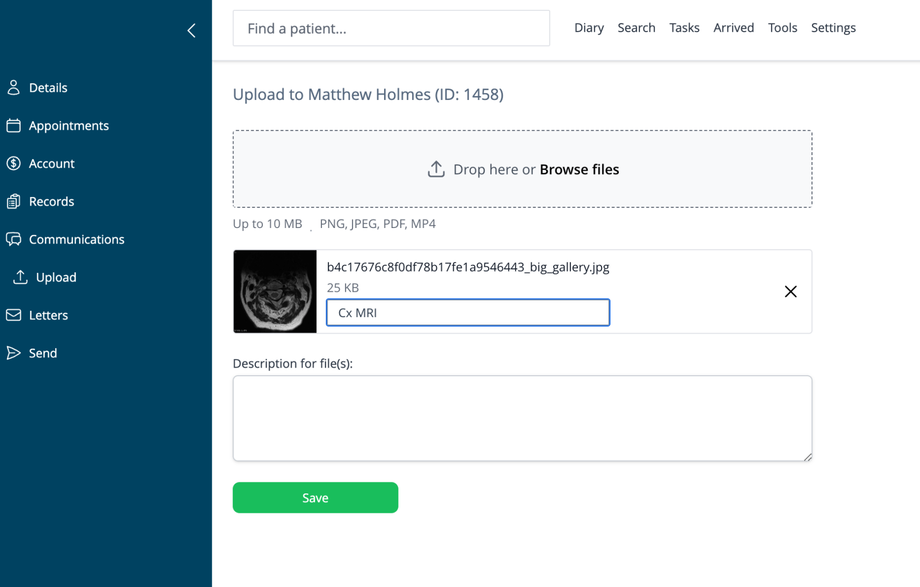Overview
The Patient Upload screen allows you to add documents, images, and other files to a patient's record. This feature is essential for storing and organizing external medical records, diagnostic images, referral letters, and other important patient documents within the practice management system.
Accessing the Upload Screen
- Navigate to a patient's record
- Click on Upload in the left navigation menu
Uploading Files
File Selection
There are two ways to add files:
- Drop here: Drag and drop files directly into the dotted upload area
- Browse files: Click to open a file selection dialog and choose files from your computer
File Requirements
- File size limit: Up to 10 MB per file
- Supported formats: PNG, JPEG, PDF, MP4
- Other formats may not be accepted by the system
Managing Uploaded Files
File Information
For each uploaded file, you can:
- See a preview thumbnail (for images)
- View the current filename and file size
- Add a descriptive file name (e.g., "Cx MRI" for a cervical MRI image)
- Remove files before saving (by clicking the X icon)
Adding Descriptions
- Individual file labels: Enter short, specific identifiers in the field below each file
- Description for file(s): Add detailed notes about the uploaded documents in the larger text area
- Descriptions help identify the content and relevance of files for future reference
Saving Uploads
- Add appropriate labels and descriptions
- Click the Save button to add the files to the patient's record
- Once saved, files will be accessible from the patient's clinical records page
Best Practices
File Naming and Organization
- Use clear, descriptive labels that identify the type of content
- Include date information when relevant in descriptions
- Categorize files appropriately (e.g., "Lab Results," "Imaging," "Correspondence")
Clinical Documentation
- Note the source of external records in the description
- Include the date when records were created (if different from upload date)
- Reference any relevant findings or observations that relate to the patient's care
Privacy and Security
- Only upload files relevant to patient care
- Ensure you have appropriate permission to store external records
- Verify you're uploading to the correct patient record
File Management
- Uploaded files become part of the patient's permanent medical record
- Consider which files are essential to store in the system
- For large imaging studies, consider uploading key images rather than complete studies
- Review older uploaded files periodically to ensure they remain relevant
Common Upload Types
- Diagnostic imaging (X-rays, MRIs, CT scans)
- Specialist reports and letters
- External lab results
- Hospital discharge summaries
- Patient-provided documents
- Consent forms
- Insurance documentation

